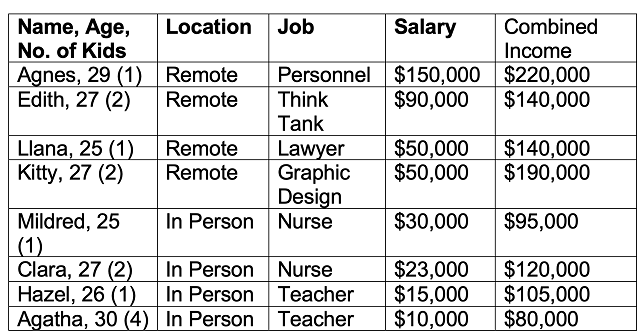Highlights
- Side-hustling tradwives represent a growing trend that will continue regardless of public policy, since it is an adaptation to eternal needs. Post This
- For the women I spoke to, the side-hustle fuels the family’s ability to live the American dream, broadly understood. Post This
- Side-hustle wives are ambitious, intelligent women who are finding ways to help with family finances, improve the family's quality of life, and doing extra work they enjoy. Post This
More conservatives are embracing traditional sex roles but often with little clarity about what tradition means. Tradwives contrast to modern feminism’s independent woman, whose identity rests in gaining emotional and economic independence from family life.
As I’ve argued before, tradwives come in three types. Trad-tradwives mind the household without working for pay. An “eras” tradwife works before having children and then after the children leave the home. The side-hustle tradwife, America’s contribution to family life, works part-time while children are at home.
Around 70% of American mothers work, but most women with children prefer not to work full-time. In 2015, Gallup found that nearly 60% of mothers with children under 18 prefer a homemaker role. A 2019 IFS research brief shows that 63% of married mothers believe it is ideal either not to work at all or to work part-time. Side-hustle wives are increasingly a norm among middle- and upper-middle class families.
To learn more about this, in June of this year, I conducted in-depth interviews with eight mothers with children under age five who work part-time. All of the women were college graduates, and their family earns more than the national average for college graduates under 30 (about $75,000 per household). All of the women had babies earlier than the average age for having a first child in America (nearly 28). All attend church weekly, and all are on-track to have at least three children. Half own homes, though less than 40% of couples under age 35 own them. This is an above average crowd, in a sense (see Table in Appendix).
Remote v. In-Person
None of the side-hustle mothers I spoke to work more than 20 hours a week. Half of them work remotely. Flexible remote work allows mothers to prioritize children. For example, Agnes is a personnel specialist. Her lucrative job is mostly done between 5:00 am and 8:00 am, since her clients work mostly during Eastern time. Special calls are scheduled during nap time and occasionally her child sits on her lap during meetings. During the rest of the day, she raises her daughter and minds their home. She hangs out with other mothers in her neighborhood and through church.
Other remote side hustlers tell much the same story.Work fits around child care and minding the household. Llana writes briefs before 8:00 am and during naps, just when Kitty does her graphic design work. Edith does much the same, with occasional work in the evening.
Those working in person get help from extended families (Mildred and Clara), a husband with a flexible schedule (Agatha), or a church community that provides child care (Hazel). Logistics are a challenge but not insurmountable.
Some employers are sympathetic to side hustlers and want to help high-quality women be mothers and stay in the workforce, so they don't ask too many questions.
Why work?
For the women I spoke to, the side hustle fuels the family’s ability to live the American dream, broadly understood. Agnes and her husband “need two incomes to live the American dream, owning a house in a nice suburb, sending kids to private school, buying organic groceries.” For them, the American dream is more about living well.
Many trad-tradwives manage the domestic side of family operations and whisper sweet ambitions in a husband’s ear. Side-hustling wives do something different. Llana and Edith look forward to the day when their husbands can fulfill career ambitions, while they help. Llana’s husband hopes to establish a law firm and an educational foundation: she will help with incorporations and write key briefs for the practice. Edith’s husband is training to be clergy. She hopes to be an active, model wife who helps build community in his future church. In each of these cases, it is as much skills as money that the side hustlers contribute. Agatha is part of a team with her husband, a college professor. She teaches adjunct and supports his work by mentoring young co-eds in motherhood.
Agnes’s side-hustle allows her husband to do public-sphere work:
His is a community-focused job dedicated to making a world better for our kids. My work is monetary. I like the idea that I can make money so he can make the world a better place. My job is just a means to an end. We are lucky that I have a flexible, well-paying job so that he can pursue more important ambitions.
Supporting her husband’s work is “where I shine the most as a wife,” as Agnes shared with me. The family would make substantial adjustments to keep her job, even if her husband earned more.
Side-hustles also help husbands stay more engaged with the family. For now, Llana’s side-hustle allows her husband to work less and for less. He could earn enough to cover student loans (about $200K) and get a home if he worked 60-80 hours a week at a public firm. Instead, he works between 40-45 hours a week for political causes they believe in. As she told me:
My husband can do his law job so that long-term we can have a better family-work balance. In a firm, family life would be worse. There is a cost to public work, though. The pay is on a much lower trajectory than in a firm. Side-hustling makes it possible for him to have a lower salary, lower-stress job, and we get a better marriage and family life.
Llana will probably stop side hustling after her second child (she has a 10-month-old), and then her husband will probably have to earn more. For now, they are using the runway her part-time job provides to bolster his credentials.
Other husbands have work-a-day jobs—an electrician, a physician’s assistant, roofing sales, and finance. Most of the husbands work to provide. Kitty’s husband, a physician’s assistant, plans to build a home on land they purchased, though now they live in their grandparent’s old home. Hazel’s husband has gotten successive jobs to earn enough for the family and side-hustles himself as a basketball official.
All of the women I spoke to eschew the feminist model. None have close friends who were opposed to marrying and having children or who put their kids in day care. When push comes to shove, they believe their husbands must provide for the family. As Hazel said, “it is [my husband’s] job to take care of me and our child.”
I asked every side-hustle wife under what conditions she would stop working. As they have more children, many imagine transitioning to full-time homemaking. Clara is quitting her nursing job with her second child. Others mention how a second child will bring adjustments, but they will meet them with flexibility.
Others say they will keep working because they find the work fulfilling. For example, Hazel, a part-time teacher, said that “working [is] the essence of the human.” Edith agreed, “Work is noble,” she said.
“For me,” said Kitty, the graphic designer, "it is a creative outlet to break up the day. Momming can be monotonous. I like some ‘me’ things that are not simply mom things. Freelance work fills the gap."
Mildred concurred, "I love my job...When I can use my nursing skills, I feel accomplished. I like homemaking, but I get a lot of value from nursing."
All of the women see their work as mothers as noble, fulfilling, and worth the sacrifice—the most important thing in their lives. Nearly all keep busy social lives, though the side hustles can get in the way. Remote workers seem to have an easier time with this. For example, both nurses are too tired to socialize on workdays. Both teachers feel embedded in strong communities, so others pitch in out of appreciation.
These side-hustle wives are happy and almost evangelistic about how they get things done. They love being mothers. They are ambitious, intelligent women who are finding ways to help with family finances, improve the couple’s quality of life, and doing extra work they enjoy.
Side-hustling tradwives represent a growing trend that will continue regardless of public policy, since it is an adaptation to eternal needs. Side hustling could be helped along, though. For policy, supporting part-time work for moms means removing obstacles and encouraging employers. Laws that inhibit employers from treating side-hustle moms differently and better should be removed from the books, so employers can enjoy helping families while hiring conscientious employees.
Scott Yenor is Senior Director of State Coalitions at the Claremont Institute’s Center for the American Way of Life and a professor of political science at Boise State University.
Appendix Table: Profiles of Eight Side-Hustle Wives














